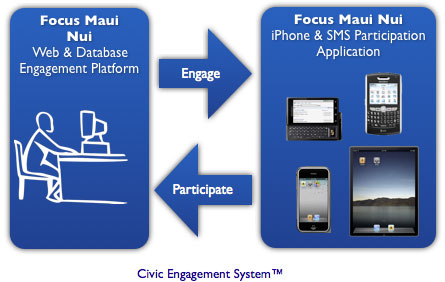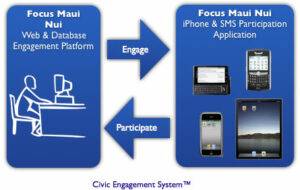
Dec 17, 2010 | Education
 We need your help with securing a major grant from the Hawaii Community Foundation’s Island Innovation Fund. The process is now in the “Collaboration” phase and we need feedback to strengthen our proposal before the final submission.
We need your help with securing a major grant from the Hawaii Community Foundation’s Island Innovation Fund. The process is now in the “Collaboration” phase and we need feedback to strengthen our proposal before the final submission.
Please review our proposal at the Island Innovation Fund website and give us your candid feedback by leaving a comment on their site—positive and negative—by noon, Monday December 20.
The Island Innovation Fund is a groundbreaking approach to advancing extraordinary innovations for our community. It is looking for projects that are innovative, ripe, scalable, leveraged, and achievable. It is expected that no more than 8 grants will be awarded.
In our proposed concept, MEDB builds on the Focus Maui Nui community engagement program to create a Civic Engagement System™. This “high tech, high touch” system is centered on the internet and mobile devices, with a phone app that will expand and transform the penetration of Focus Maui Nui.
The Civic Engagement System™ will strengthen and enliven community engagement on issues identified as priorities by the community and will mobilize greater numbers of constituents in policy and decision-making processes. The system extends informed discourse by continuing the Focus Maui Nui practice of making it as convenient as possible for residents to participate.
We look forward to hearing from you by Monday December 20th. If you prefer to call with comments, please contact John Harrisson at 808 270-6806.
Dec 15, 2010 | Small Business
 Focus Maui Nui participants have consistently cited the value of small businesses in our community as an important economic asset. One small business that has survived successfully in a changing marketplace is Hamai Appliance, in large part because it has adapted to the change. But a business also survives by doing what it does best. Doing both is Hamai Appliance’s not-so-well-kept secret to success.
Focus Maui Nui participants have consistently cited the value of small businesses in our community as an important economic asset. One small business that has survived successfully in a changing marketplace is Hamai Appliance, in large part because it has adapted to the change. But a business also survives by doing what it does best. Doing both is Hamai Appliance’s not-so-well-kept secret to success.
“We’re fortunate that we’re still around, but I think one of the reasons is we continue to provide servicing for what we sell,” says President Clyde Hamai. “That’s what makes us different from our larger competitors; we do our own servicing.”
The last independent appliance/electronics businesses on Maui, Hamai recalled when all the appliance stores were locally owned businesses. Maui’s growth brought more customers, and it also brought the warehouse retailers.
Since his parents, Lester and Clara Hamai, founded the appliance business in September 1969, the business has adjusted its product line. It relies on mainstays Panasonic and GE, but there are new lines such as top-end brands like Sub-Zero, Wolf, and Thermador – and new merchandise such as Simmons mattresses.
Hamai joined a national buying group to counter the purchasing strength of the “big box” warehouse stores and set up its own website, www.hamai.appliance.com. “The customers have changed too,” observes Hamai. But Hamai Appliance customers know what they are getting: quality products, service and a staff of 18 people who know their products. “When you’re small, everybody has to do everything,” he says.
“Sure, the larger stores may sometimes undercut us on pricing, but we have a track record for servicing. At most of our competitors, if something breaks, the customer has to find someone else to fix it, and there are some brands for which there is no local servicing available. We even keep records of our customer’s major purchases in our system so they won’t have to worry about warranty information. Our customers recognize that.”

Dec 8, 2010 | Community

Pūlama Collier with her son Kia‘i Collier, a Kula Kaiapuni senior at King Kekaulike High School.
“Our public schools have been a mainstay for maintaining the consciousness of Hawaiian traditions without the community knowing it,” reflects Pūlama Collier, State Resource Teacher with the Department of Education for Hawaiian Language Immersion Program at King Kekaulike High School.
The immersion program on Maui, Kula Kaiapuni, has been an integral part of preserving Hawaiian culture on the island since 1989, when its first Kindergarten class began at Paia School. Today, there are about 220 students participating in Hawaiian language immersion classes at 4 public schools on Maui: Two at the elementary level (Paia School and Princess Nahienaena Elementary in Lahaina); Kalama Intermediate (Makawao); and King Kekaulike High School (Pukalani).
Statewide, there are 26 language immersion sites, with each island and community offering different models. In some cases, on Oahu and the Big Island, whole schools offer Hawaiian language immersion. On Maui, Kula Kaiapuni is “a school within a school”, as Pūlama observes, with certain classes offering instruction in all subjects in the medium of the Hawaiian language. Within the program, English language arts as a subject is introduced at the 5th grade level to ensure bilingual skills. Kula Kaiapuni, mandated by the State Constitution, is offered by the Department of Education to all families that choose it for their children.
Last week, Kula Kaiapuni students from all four Maui school sites participated in Na Mele O Maui, the annual Hawaiian Song and Art competition, held at the Maui Arts and Cultural Center. They distinguished themselves by winning either first or second place in the music categories.
Dec 1, 2010 | Education
 Iokepa Nae`ole proudly traces his family’s ancestry back to the time of King Kamehameha’s infancy, on the Big Island. Teaching comes naturally to Nae`ole and the vocation has always run in his family. Many know Nae`ole as a canoe paddling coach; he has been an integral part of the statewide success of the Kahului-based Hawaiian Canoe Club and helped guide King Kekaulike High School to a State paddling championship in 2004. He is also an active environmentalist, cultural advocate, and mentor.
Iokepa Nae`ole proudly traces his family’s ancestry back to the time of King Kamehameha’s infancy, on the Big Island. Teaching comes naturally to Nae`ole and the vocation has always run in his family. Many know Nae`ole as a canoe paddling coach; he has been an integral part of the statewide success of the Kahului-based Hawaiian Canoe Club and helped guide King Kekaulike High School to a State paddling championship in 2004. He is also an active environmentalist, cultural advocate, and mentor.
 Nae`ole’s latest project is the Hawaii Outdoor Experience, a pilot educational initiative funded by the State Office of Youth Services and administered through Neighborhood Place of Wailuku. The program provides up to 80 teenagers with after-school and weekend activities, and “campovers”; parents are invited to go through the program too. Ropes courses offer team building, personal development, trust and leadership skills. Canoe paddling provides a healthy outlet and a metaphor for community life. To function successfully, a canoe crew needs to move in the same direction, contribute to the team while focusing on their specific task, and place trust in the steersman. Long-distance runs and canoe excursions are planned for some weekends.
Nae`ole’s latest project is the Hawaii Outdoor Experience, a pilot educational initiative funded by the State Office of Youth Services and administered through Neighborhood Place of Wailuku. The program provides up to 80 teenagers with after-school and weekend activities, and “campovers”; parents are invited to go through the program too. Ropes courses offer team building, personal development, trust and leadership skills. Canoe paddling provides a healthy outlet and a metaphor for community life. To function successfully, a canoe crew needs to move in the same direction, contribute to the team while focusing on their specific task, and place trust in the steersman. Long-distance runs and canoe excursions are planned for some weekends.
“We need to educate our young people about traditional values, stewardship, and community life,” says Nae`ole. “The cultural element of the HOE curriculum is about connectedness, developing kinship with the land and ocean. My philosophy revolves around the 3 “E”’s: Experience, exposing youth to real world situations and to the natural world, away from electronics, the mall, and other superficial, material things; Education, especially on environmental and cultural issues; and Empowerment – letting young people know they can to something about their world, whether it’s taking personal action, writing to a County or State official, or attending an event.
“Prevention is an important aspect of the program,” adds Nae`ole. “The young people get so involved and feel so good about their activities, maintaining a positive outlook, they don’t waste their time or have opportunities to get into trouble.”
Nov 24, 2010 | Education
 When a state-of-the-art photovoltaic (PV) system was installed on the roof of the Ke Alahele building in the Maui Research and Technology Park, a unique opportunity presented itself for two Maui students to show what they could
When a state-of-the-art photovoltaic (PV) system was installed on the roof of the Ke Alahele building in the Maui Research and Technology Park, a unique opportunity presented itself for two Maui students to show what they could
contribute. The PV system is linked to a sophisticated energy storage system, demonstrating the technical potential of cutting-edge technologies as Maui County moves to increase renewable energy sources and reduce its dependence on imported fossil fuel.
It took Kurt Rasos and Nick Mahoney, working as interns with the Maui Economic Development Board in Spring 2010, to explain the system details clearly and concisely in terms a nontechnical audience can understand – an important
teaching tool. The final display makes it readily apparent that the technology demonstrated here can be scaled up to make larger renewable energy generation with battery storage installations a reality. The PV system not only powers parts of the Ke Alahele building, but the batteries serve as a buffer to the MECO system and turn the training room into an emergency preparedness facility with back-up power.
Nick, a senior at King Kekaulike High School, and Kurt, a recent graduate of Maui High School who currently attends the Art Institute of Portland, are both Project EAST students. They joined forces to create a series of explanatory
displays on the PV energy system and an informative brochure for people to take with them. Nick, the engineering half of the team, explains the process: “We took what we learned about PV panels and put it together so we could explain it to people who don’t have any background in electricity or technology.” Kurt, the graphic designer, comments: “It was really fun. I learned a lot about the technology and I enjoyed working on the explanations.” Both interns say they have been inspired by what they learned. “It’s all part of the learning stream,” says Nick.

 We need your help with securing a major grant from the Hawaii Community Foundation’s Island Innovation Fund. The process is now in the “Collaboration” phase and we need feedback to strengthen our proposal before the final submission.
We need your help with securing a major grant from the Hawaii Community Foundation’s Island Innovation Fund. The process is now in the “Collaboration” phase and we need feedback to strengthen our proposal before the final submission.




